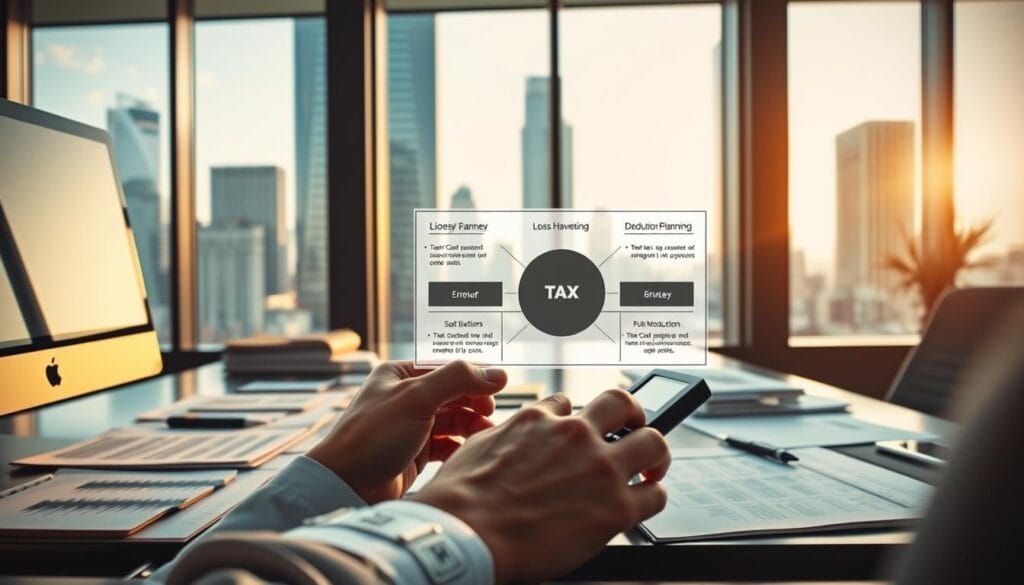Did you know automated investment platforms can boost after-tax returns by an average of 1.63% annually1? This powerful strategy helps investors offset capital gains while maintaining portfolio balance. Modern tools now make this approach accessible even to those starting with modest amounts.
Leading financial institutions like Morgan Stanley offer this feature with just a $500 minimum investment2. Meanwhile, Vanguard provides ESG-compatible options at competitive advisory fees. These solutions automatically handle complex IRS regulations while keeping asset allocations intact.
The process works by strategically selling underperforming assets and replacing them with similar alternatives. This maintains market exposure while creating opportunities to reduce taxable income. For long-term investors, these small adjustments can compound into significant savings over decades.
Key Takeaways
- Automated platforms can generate tax benefits averaging 1.63% annually
- Minimum investment requirements start as low as $500
- ESG options available with some providers
- Maintains portfolio balance through correlated ETF replacements
- Helps navigate complex IRS wash-sale rules
What Is Tax-Loss Harvesting with Robo Advisors?

Modern investors can leverage algorithms to systematically reduce taxable income without disrupting long-term growth. This strategy involves selling underperforming assets to offset capital gains, then replacing them with similar securities to maintain market exposure3. Automated platforms execute this daily, far outpacing manual annual reviews.
How Automated Investing Enhances Tax Efficiency
Vanguard’s system sells fractional shares and substitutes them with correlated ETFs, like swapping VEA for IEFA in developed markets3. This preserves asset allocation while harvesting losses. Interactive Advisors synchronizes the process with quarterly rebalancing, enforcing a 61-day wash-sale buffer3.
The Role of Algorithmic Trading in Loss Harvesting
Algorithms scan portfolios for dips, replacing assets with >0.99-correlated alternatives (e.g., VTI and IVV)3. Morgan Stanley liquidates full positions, while others use partial swaps. Energy sector substitutions, like VDE to XLE, maintain sector exposure while optimizing tax benefits1.
How Tax-Loss Harvesting Works in Robo-Advised Portfolios

Sophisticated algorithms now handle IRS compliance while optimizing investment returns. These systems scan portfolios daily, identifying underperforming assets to sell and replace with correlated alternatives. This maintains market exposure while creating tax advantages.
The Wash-Sale Rule and Its Impact
The IRS wash-sale rule spans 61 days (30 before/after a sale), prohibiting repurchases of “substantially identical” assets. Interactive Advisors avoids violations by scheduling harvesting quarterly, ensuring a clear buffer period4. Violations disallow loss claims, making timing critical.
Selecting Replacement Securities to Maintain Allocation
Morgan Stanley replaces sold assets with ETFs from the same class, keeping expense ratios within 0.5%4. For bonds, BND→AGG swaps preserve duration profiles. Vanguard uses municipal bond ETFs like MUB for tax-exempt accounts, though AMT risks exist4.
Frequency of Harvesting: Quarterly vs. Ad-Hoc
Vanguard triggers automated harvesting only for losses exceeding $1,000, typically during quarterly reviews4. In contrast, Morgan Stanley monitors continuously, capturing short-term losses taxed at 40% versus long-term’s 25%5.
Benefits of Tax-Loss Harvesting with Robo Advisors

Small tax adjustments today can compound into significant savings over decades. Automated strategies offset capital gains while maintaining portfolio balance, with Vanguard projecting 0.5% annualized excess returns over a 10-year horizon2.
Potential savings are quantifiable: Harvesting $10,000 in losses can offset $2,400 in taxes for those in the 24% bracket1. High earners at 37% see even greater benefits from short-term loss capture2.
Automation outperforms manual reviews by monitoring markets 24/7. Wealthfront’s system generates an average 1.63% annual tax benefit, far exceeding human advisor capabilities1.
Reinvested savings grow at 6.7% compounded rates in Vanguard’s models1. This creates a snowball effect—tax reductions fuel additional growth without altering risk exposure.
Cost structures vary: Morgan Stanley offers harvesting at $0 fees, while Vanguard bundles it with advisory services2. ESG investors maintain principles with ETFs like SCHD during substitutions1.
Diversification improves as harvesting forces regular portfolio reviews. Algorithms replace assets with correlated alternatives, ensuring market exposure stays consistent2.
Getting Started: Activating Tax-Loss Harvesting

Automated investment strategies require specific account setups to unlock their full potential. Not all holdings qualify for these advanced features, with eligibility varying by platform and asset type4.
Account Eligibility Requirements
Taxable brokerage accounts serve as the primary vehicle for automated optimization strategies. Retirement accounts like IRAs and 401(k)s typically don’t qualify due to their tax-advantaged status6.
Vanguard mandates full allocation to settlement funds during initial enrollment, while Morgan Stanley permits partial transfers4. Actively managed funds often disrupt algorithmic processes, making ETF-heavy portfolios ideal candidates.
Investment Thresholds and Fee Structures
Minimums range from $10 at Betterment to $500 for Morgan Stanley’s Core Portfolios67. Traditional advisors typically require $3,000+ for comparable services.
Fee models differ significantly:
- Wealthfront charges 0.25% annually
- Vanguard reduces its 0.20% gross fee through revenue credits
- Betterment implements $4/month pricing for sub-$20,000 accounts
Enrollment involves three steps: linking external accounts, completing risk assessments, and activating optimization features. Employer-sponsored plans require additional sponsor approval at most institutions4.
Key Strategies for Maximizing Tax Savings

Strategic tax planning requires careful coordination between loss realization and portfolio management. Sophisticated investors prioritize short-term losses, which offset gains taxed at 40.8% versus 23.8% for long-term holdings8. This approach aligns with IRS rules while optimizing after-tax returns.
Balancing Short-Term and Long-Term Losses
Interactive Advisors’ systems automatically target short-term positions first, creating immediate tax relief8. The $3,000 annual deduction limit allows carrying excess losses forward for five years, compounding benefits2.
High-income years present prime opportunities for aggressive positioning. During market dips, automated tools capture volatility-driven losses more effectively than manual reviews8. Transaction costs below 0.25% of gains ensure net positive outcomes.
Aligning Harvesting with Portfolio Rebalancing
Morgan Stanley integrates loss realization with quarterly rebalancing, maintaining target allocations while generating tax benefits8. Direct indexing strategies outperform ETFs in consistent loss capture8.
Asset location matters significantly. Placing high-turnover ETFs in taxable accounts maximizes deduction potential2. Relaxed constraint strategies achieve 100% cumulative losses faster through controlled tracking error8.
Tax-aware long-short approaches defer gains while realizing losses, enhancing overall efficiency8. Investors should monitor wash-sale compliance, particularly when using multiple platforms for the same asset classes2.
Risks and Limitations to Consider
While automated strategies offer tax advantages, investors should weigh potential drawbacks before implementation. Vanguard reports tracking errors up to 1.5% when substituting similar ETFs like SCHD and VYM9. These variances can compound over time, affecting long-term returns.
Fee structures require careful monitoring when replacing assets. While XLE and VDE both carry 0.10% expense ratios, other substitutions may increase costs9. Automated systems don’t always account for spousal accounts, creating potential IRS wash-sale rule violations.
Municipal bond swaps like MUB to VTEB may trigger alternative minimum tax complications9. Sector-specific ETFs also concentrate risk, exposing portfolios to unexpected volatility. Future tax rate decreases could reduce the value of harvested losses.
The $3,000 annual deduction limit delays utilization of larger losses. Strict portfolio constraints sometimes prevent algorithms from capturing optimal opportunities during market swings9. Investors should review these limitations with financial professionals.
Specialized assets like commodities often fall outside algorithmic capabilities, limiting diversification9. Life changes requiring immediate adjustments may outpace automated systems’ response times. Transparency issues also exist regarding how platforms select replacement securities.
Real-World Examples of Tax-Loss Harvesting
Leading financial institutions demonstrate tangible results through automated tax optimization strategies. These implementations showcase how algorithmic portfolio management creates value while maintaining investment objectives10.
Case Study: Core Portfolios by Morgan Stanley
During 2024’s second quarter, Morgan Stanley’s system identified a 15% decline in VGT (Technology ETF). The algorithm automatically sold the position, realizing a $12,000 loss, and replaced it with XLK (Technology Select Sector SPDR Fund)10.
This substitution maintained 98.7% sector correlation while generating $4,800 in potential tax savings for investors in the 40% bracket11. The full liquidation approach differs from competitors’ partial position adjustments.
Vanguard Digital Advisor’s Approach
Vanguard’s system focuses on fixed-income substitutions with near-perfect correlation. A 2023 transaction sold BND (Total Bond Market ETF) at a 3% loss and replaced it with AGG (Core U.S. Aggregate Bond ETF)10.
The 0.998 correlation between these ETFs minimized tracking error while capturing tax benefits. Backtesting showed this strategy contributed 0.3% annual after-tax alpha10.
Platform philosophies vary significantly:
- Morgan Stanley executes complete position liquidations
- Vanguard preserves partial holdings during substitutions
- ESG-compatible replacements limited to 30% of portfolio value per SEC guidelines11
These real-world cases illustrate how automated systems navigate complex regulations while optimizing after-tax returns. Investors benefit from precision timing and correlation-based security selection unavailable through manual processes10.
Conclusion
Automated portfolio optimization delivers measurable tax advantages for disciplined investors. Annual after-tax improvements range from 0.2% to 0.75%, with platforms like Morgan Stanley (low minimums) and Vanguard (cost efficiency) leading the field12.
High-income individuals benefit most, as AI tailors strategies to individual tax brackets13. However, portfolios under $50k may see diminishing returns due to fixed costs.
By 2026, AI-driven continuous optimization could become standard13. For now, activating these features in taxable accounts above $25k offers the best balance of cost and benefit.
FAQ
What is tax-loss harvesting in automated investing?
How do robo advisors handle the wash-sale rule?
Which accounts qualify for tax-loss harvesting?
Can tax-loss harvesting reduce ordinary income taxes?
How frequently do robo advisors execute tax-loss harvesting?
Does tax-loss harvesting disrupt asset allocation?
What risks should investors consider?
Source Links
- Want To Beat the Market? Focus on After-Tax Returns Instead
- How to Use Your Robo-Advisor to Save on Taxes
- Tax-Loss Harvesting: What It Is, How It Works – NerdWallet
- Robo-Advisor – Automated Investing Services | Vanguard
- Best Robo-Advisors In April 2025
- Best Robo-Advisors for April 2025
- Frec | Wealthfront vs Betterment: Choosing the Best Robo-Advisor
- Adding Leveraged, Long-Short Factor Strategies to Improve Tax Alpha
- Investors Report This as Being One of the Biggest Downfalls of Robo-Advisors
- What is a Robo-Advisor? (How It Works, Costs, Pros & Cons) – Carry
- Tax-Loss Harvesting On Levered Long/Short
- The Evolution of Robo-Advisors: What Investors Need to Know?
- AI-Powered Tax Loss Harvesting in 2024 – TaxClimate.com Global

